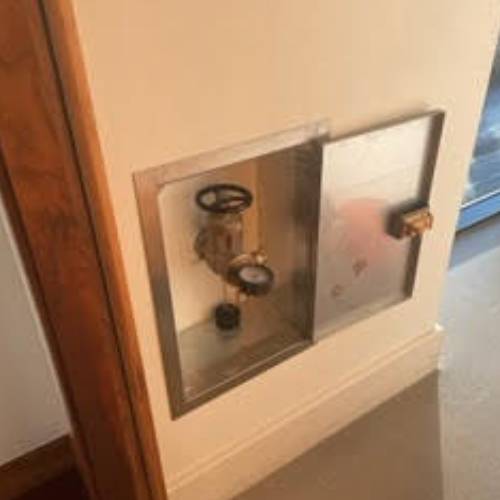Dry Riser Testing and Maintenance

What is a Dry Riser System?
Dry risers are used to deliver water within buildings for fire-fighting purposes. The provision of a built-in system means that firefighters do not need to create their own distribution system in a building in order to fight a fire and it avoids the breaching of fire compartments by running hose lines between them.
Dry risers do not contain any water when they are not in use but are charged with water by the fire service pumping appliances when necessary.
Dry risers have an inlet valve at ground level for service vehicle access and landing valves at locations on each floor.
Part B of the building regulations (Fire Safety) requires that fire mains are provided in buildings that are more than 18m tall. In buildings less than 50m tall, fire mains can be either dry or wet risers, however, where a building extends to more than 50m above the rescue service vehicle access level, wet risers are necessary as the pumping pressure required to charge the riser is higher than can be provided by a fire service appliance, and to ensure an immediate supply of water is available at a high level.
Each inlet connector should be within 18m of a fire service appliance access. Inlet connectors are typically contained inaccessible, but secure enclosures on the external face of buildings and are identified as a dry riser inlets.
Typical Dry Riser Inlet breeching
Dry risers should be within protected fire-fighting shafts, and where necessary in protected escape stairs. Dry-riser outlets or landing valves may be located in protected lobbies, stairs, or enclosures where these are available and highlighted with the correct signage.
Typical Dry Riser outlet valve housing
At the top of the dry-riser pipework, an air valve is provided to allow air in the dry riser to escape when the riser is charged with water.
Dry risers should be inspected and tested regularly to ensure equipment is functioning correctly and ready for use. Problems can be very serious in the event of a fire and are typically caused by vandalism or theft, blockages or pipework and air valve failure, or by connection failure or outlets being open.
In the event of a fire and the fire service needs to deliver water to an upper floor level the Dry Riser must function correctly, failure can be catastrophic and seriously endanger life and property.
Dry Riser testing and maintenance need to be carried out annually, with six-monthly visual inspections as detailed in British Standard 9990.
What’s involved in a dry riser inspection?
The whole process of carrying out a dry riser inspection can involve a considerable amount of planning before even arriving on site. For example, if the site is located in a busy town or city then a number of questions need to be asked and appropriate actions carried out, such as:
- Is parking suspension / dispensation required? This often entails seeking permission from local authorities and / or parking enforcement bodies.
- The dry riser testing equipment is based on a large and heavy vehicle which needs to be as close to the inlet as possible in order avoid causing obstruction or danger to pedestrians.
- Wet testing should not take place if temperature is below freezing, there would be a danger of pipes freezing and causing major damage. There is also the risk of water being spilt and causing a slip hazard to pedestrians.
- Once the testing equipment is on site the operatives will cordon off the areas affected by the testing, thus making it safe. An initial visual inspection of the system must be carried out prior to the system being filled and pressurized with water.
- The system is then charged with water and pressurized to 12 bar (175 psi) and held at this pressure for a total of 15 minutes to check that the pressure can be maintained within the system.
- Following the completion of the dry riser system testing, the system pipework is drained, outlet valves closed and secured with padlocks and straps, and the inlet breeching cabinet closed and locked.
Don’t get caught out in an emergency fire situation. Without fully working dry risers this could pose a considerable threat to loss of life and property. Without regular testing and maintenance of your dry risers, you won’t know if they will operate effectively when most needed. There is more to dry riser testing than meets the eye.
Dry risers do help save lives and you could be prosecuted if they have not been regularly tested and inspected in accordance with relevant standards.